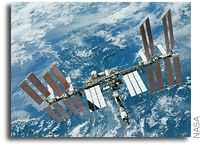NASA International Space Station Research Highlights 24 January 2011

Scott Kelly completed another session with the Nutritional Status Assessment (Nutrition). This comprehensive in-flight study is designed to understand changes in human physiology during long-duration spaceflight. This study includes measurements of bone metabolism, oxidative damage, and chemical and hormonal changes; as well as assessments of the nutritional status of the crew members participating in the study. The results have an impact on the definition of nutritional requirements and development of food systems for future space exploration missions.
Paolo Nespoli and Cady Coleman made successful contacts with schools in Italy, Poland and Kentucky as part of the International Space Station HAM Radio experiment (ISS HAM Radio). Eleven passes have been completed this year and 576 have been completed for the program. By utilizing ham radios, this experiment gets students interested in space exploration by allowing them to talk directly with the crews living and working aboard the space station.
The Hyperspectral Imager for the Coastal Ocean (HREP-HICO) Experiment Payload has taken 2,485 images to date, including recent images of the Bahamas, Railroad Valley Playa in Nevada and the southern part of Lake Baikal in Russia. The experiment analyzes the water clarity, chlorophyll content, water depth and ocean or sea floor composition for naval purposes. Nespoli and Coleman performed their second session with the Mental Representation of Spatial Cues During Space Flight (3D-Space) experiment. This European Space Agency experiment investigates the effects of exposure to microgravity on the mental representation of spatial cues by astronauts during and after spaceflight. The absence of the gravitational frame of reference during spaceflight could be responsible for disturbances in the mental representation of spatial cues, such as the perception of horizontal and vertical lines, the perception of an object’s depth, and the perception of a target’s distance.
The European Space Agency-designed Fluid Science Lab Microgravity Vibration Isolation Subsystem was successfully commissioned. The Microgravity subsystem is designed to allow experiments to be conducted in low gravity without interference from vibrations produced by the space station. It will monitor the position of the core element of the Fluid Science Lab (FSL) and is armed with an extremely sensitive accelerometer that can chart movement or vibration aboard the station. It uses a magnetic field to suspend a container for experiments.
Jorge Sotomayor, Lead Increment Scientist Expedition 25/26








